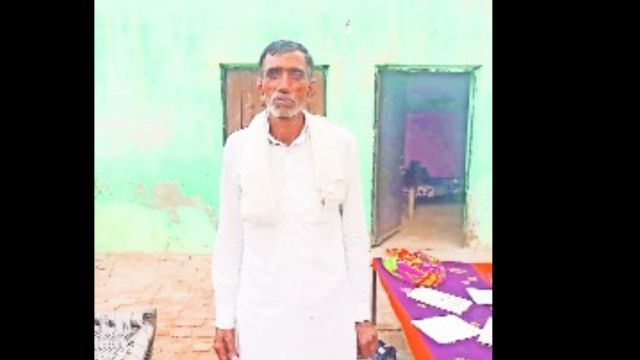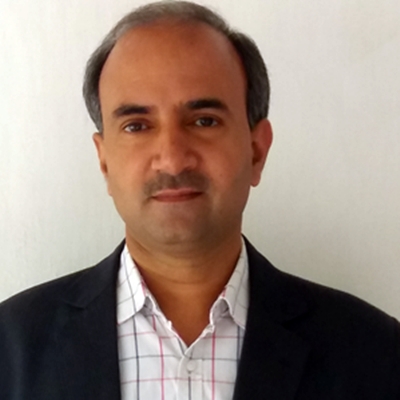2 land mutations, a 117-yr-old dispute and a 55-yr-old’s battle for his ‘fair share’ in Haryana
As per details, the case in question involves one Sher Singh Rana, who has been trying to get a 117-year-old land mutation record in order to get "his due share of land" in his native village of Tankari in Haryana’s Rewari district.
 Sher Singh Rana
Sher Singh Rana A 55-year-old man’s lone battle to get his “fair share” of land has brought to the fore a strange case of land mutation in Haryana, with none other than the state’s Chief Minister, Manohar Lal Khattar, acknowledging that revenue officials of the administration had been struggling to solve the 117-year-old dispute.
As per details, the case in question involves one Sher Singh Rana, who has been trying to get a 117-year-old land mutation record in order to get “his due share of land” in his native village of Tankari in Haryana’s Rewari district.
On the administration’s part, the officials have started scrutinising related revenue documents beginning from 1896 to date to find out a solution after the matter was brought to the knowledge of Chief Minister Manohar Lal Khattar last month.
During a telephonic conversation, Rana informed the Chief Minister how an “incorrect” mutation was recorded in the revenue record for their land holdings in 1906 after a “genuine” mutation of 1902.
Khattar, on his part, recently had acknowledged how his officials were at sea as they tried to resolve the dispute. “Last year, we introduced a scheme called Vivado Ka Samadhan. One of the issues that came to my notice was that of a land mutation dispute. One of the mutations of the land took place in 1902, followed by a second mutation in 1906. The person concerned says that the 1906 mutation was wrong. I have had two IAS officers sit with me to study the matter in depth.”
According to Rana, the “grabbed” land belonged to his great grandfather Daulat Singh in Tankari village. Rana said, “The first mutation (number-566) which took place in favour of Daulat Singh’s three sons in 1902 was genuine. But then a few numberdars and villagers, in connivance with the then revenue officials, had a second mutation (number-822) done on the land on March 12, 1906 to cheat my great grandfather. My great grandfather did not come to know about these discrepancies at that time. I came to know about this in 1997 only when I had gone to Bawal tehsil office for a land issue that had cropped up between the family members.”
In the revenue record, Rana found less than half an acre (3 kanals and 1 marla) of the land under his name. According to Rana, all the descendants of Daulat currently have nearly 36 acres of land, instead of nearly 200 acres. Rana says a large chunk of their land is currently being utilised by the village panchayat.
During the past over two decades, Rana has approached multiple platforms — ranging from Tehsildars to Deputy Commissioners to Divisional Commissioners to Financial Commissioners. Officials say his contentions had been rejected at every platform in the absence of any supporting documents.
A revenue official, who is associated with the ongoing investigation in the matter, told The Indian Express, “Rana says their land records were okay till 1901 but the mutation which took place in 1906 was wrong. To verify his claims, we have seen land records of 1896, mutations of 1901 and 1906, apart from all subsequent records till 2023. As of now, we have not found any evidence which corroborates his claims.”
The official added, “In the old records, we have found an entry of mortgaged land in favour of Rana’s ancestors. However, this land was later freed by the person who had mortgaged it in favour of Rana’s ancestors. However, Rana even claims that land.”
The official further said, “In 1906, when the land revenue settlement took place, all revenue entry numbers were allotted afresh. And the same proceedings took place in 1936 again. If there was any issue, his forefathers would have raised it then. Not only this, land consolidation — meant to reorganise or redistribute fragmented lands into one plot — took place in 1960 and the same issues, if any, could have been raised then too.”
Rana is the youngest among six siblings. He lost his father due to illness in 1968, even before his birth with the family later shifting to his mother’s parental home in Rampura village of Bhiwani, where he got four acres of land—two acres as his mother’s share and two acres as gift from his mother’s brothers. In 2006, he sold three kanals and one marla land in Tankari village to buy a residential plot in Rampura.
According to details, Rana met Chief Principal Secretary Rajesh Khullar twice in connection to his case so far. Khullar, on his part, has instructed officials to resolve the matter.
Rewari District Revenue Officer, Rakesh Chhokar, said that they have formed a team of officers headed by a tehsilar, to examine the matter. The officials said a report will be sent to the Chief Minister’s office in this regard soon.
Rs 18 lakh debt
Sher Singh Rana claimed that he was at present under a debt of Rs 18 lakh, which included a crop loan of Rs 5.8 lakh. According to Rana, this financial crisis has delayed the marriage of his daughter Pooja (26) and son Neeraj (24). “I could not pay a fee of Rs 20,000 for Neeraj when he was studying in Tosham’s Industrial Training Institute (ITI) during the Covid pandemic forcing him to quit his studies midway.”
Rana hopes that if a correction is made in the mutation, he may get at least ten acres of land which may improve his financial condition.













